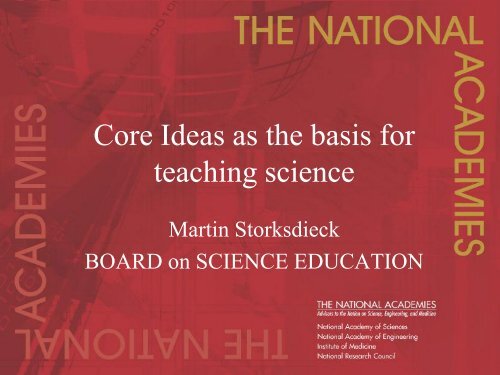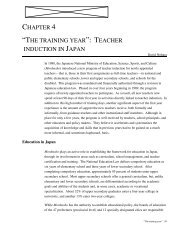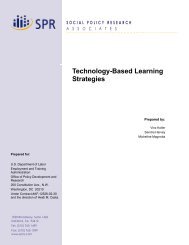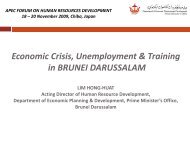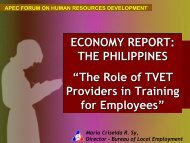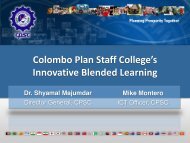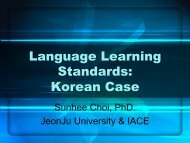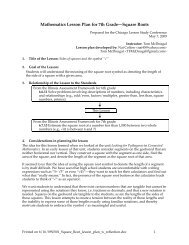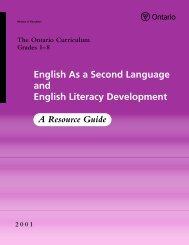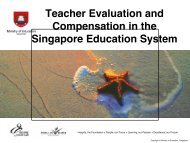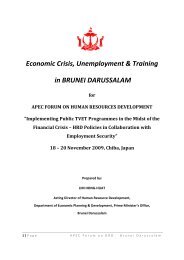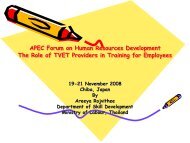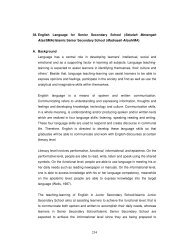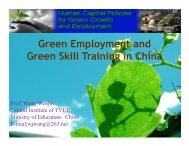Core Ideas as the basis for teaching science
Core Ideas as the basis for teaching science
Core Ideas as the basis for teaching science
- No tags were found...
Create successful ePaper yourself
Turn your PDF publications into a flip-book with our unique Google optimized e-Paper software.
Problems in US Science Education
Problems in US Science Education
NRC & BOSE Reports Related to Learning
Strands of Scientific Proficiency1. Understanding scientific explanations2. Generating scientific evidence3. Reflecting on scientific knowledge4. Participating productively in <strong>science</strong>Add two new strands: motivation/interest and identityNot separate goals — intertwined strands duringeffective learning and <strong>teaching</strong>.
<strong>Core</strong> <strong>Ide<strong>as</strong></strong> and LearningProgressions• Major recommendation from research – organizestandards around core ide<strong>as</strong> and learningprogressions.• Study of <strong>science</strong> needs to reflect <strong>science</strong>.
Why <strong>Core</strong> <strong>Ide<strong>as</strong></strong> and Learning Progressions?• Proficiency in <strong>science</strong> is more than knowingfacts. It is not a simple accumulation ofin<strong>for</strong>mation.• Factual knowledge must be placed in aconceptual framework to be well understood.• Students need to learn how ide<strong>as</strong> are related toeach o<strong>the</strong>r, and <strong>the</strong>ir implications andapplications in <strong>the</strong> discipline.
Why <strong>Core</strong> <strong>Ide<strong>as</strong></strong> and LearningProgressions?• Many ide<strong>as</strong> in <strong>science</strong> are complex or evencounter-intuitive.• It takes time (sometimes years) to fullyunderstand <strong>the</strong>se ide<strong>as</strong>.• Learning is lifelong: <strong>Core</strong> <strong>Ide<strong>as</strong></strong> = Big <strong>Ide<strong>as</strong></strong>
Standards, Curricula, and Assessment:What to Teach and When• Revise standards, curricula and <strong>as</strong>sessment to reflect newunderstanding of children’s thinking.• Next generation of standards and curricula should bestructured to identify a few core ide<strong>as</strong> in a discipline andhow <strong>the</strong>se ide<strong>as</strong> can be grown in a cumulative mannerover grades K-8.• Developers of curricula and standards need to present<strong>science</strong> <strong>as</strong> a process of building <strong>the</strong>ories and models usingevidence, checking <strong>the</strong>m <strong>for</strong> internal consistency andcoherence, and testing <strong>the</strong>m empirically.
Instruction: How to Teach• Science instruction should provide opportunities <strong>for</strong>students to engage in all six strands.• Policy makers, education leaders, and administrators needto ensure adequate time and resources are provided;teachers have adequate knowledge of <strong>science</strong> content; andadequate professional development is provided.• State and local leaders in education should provideteachers with models of cl<strong>as</strong>sroom instruction thatincorporate <strong>the</strong> six strands.
VisionExemplary <strong>science</strong> standards are: CLEAR targets <strong>for</strong> instruction and <strong>as</strong>sessment COHERENT concepts within and across disciplines MANAGEABLE <strong>for</strong> teachers and students
General Approach Identify a coherent set of <strong>Core</strong> <strong>Ide<strong>as</strong></strong> Prioritize standards that support <strong>Core</strong> <strong>Ide<strong>as</strong></strong> Eliminate nonessential content
<strong>Core</strong> <strong>Ide<strong>as</strong></strong> are:• Central to <strong>the</strong> disciplines• Broad explanatory power• Integrates many key concepts• Understanding grows over <strong>the</strong> years
<strong>Core</strong> <strong>Ide<strong>as</strong></strong> and Learning Progressions• Describe actual learning trajectories• Allow <strong>for</strong> stepping-stone concepts• Can be corrected with fur<strong>the</strong>r research
Crosscutting Content• As important <strong>as</strong> disciplinary content• May include concepts such <strong>as</strong>:• Nature of <strong>science</strong>• Process of inquiry (The practice of <strong>science</strong>)• Engineering design• Unifying principles• Habits of mind• Strands from TSS & LSIE
Towards New Science Education Standardsaround <strong>Core</strong> <strong>Ide<strong>as</strong></strong>• Develop a conceptual framework around core ide<strong>as</strong>• Improve framework b<strong>as</strong>ed on stakeholder input• Craft new <strong>science</strong> education standards• Improve standards b<strong>as</strong>ed on public and stakeholder input• Check standards against conceptual framework
An NRC Study Committee• Highly respected scientists from multipledisciplines• Experts on learning <strong>science</strong>s• Experts on education systems and policy• Supported by 5 design teams
A framework <strong>for</strong> Standards• Develop transparent criteria <strong>for</strong> selecting core ide<strong>as</strong>• Delineate core ide<strong>as</strong> – “fewer, deeper, clearer, higher”• Versions of <strong>the</strong>se <strong>for</strong> 4 th , 8 th , and 12 th grade toillustrate learning progressions• Illustrate per<strong>for</strong>mance expectations• Develop R&D agenda <strong>for</strong> future revisions
Fewer allows deeperCurrent tendency• Teach concepts without building underlyingprinciplesDesired pattern• Understanding of <strong>the</strong> connective tissue of ide<strong>as</strong>• Ability to evaluate and select in<strong>for</strong>mation
<strong>Core</strong> concepts framework<strong>Core</strong> ide<strong>as</strong> of each sub-disciplinee.g. cellular b<strong>as</strong>is of life<strong>Core</strong> ide<strong>as</strong> common across disciplinese.g. models of system with subsystems;energy flow<strong>Core</strong> skills, abilities and habits of mind (strands)e.g. interpretation of data &<strong>science</strong> argument from evidence
Critical challenges• Reaching consensus on what is core, at <strong>the</strong> right levelof detail, in each dimension• Defining <strong>the</strong>se concepts appropriately <strong>for</strong> grades 4,8, and 12 (learning progression)• Showing some examples of per<strong>for</strong>manceexpectations that honor all 3 axes of <strong>the</strong> frame
Process Principles• Transparency• Partnership• Broad involvement of stakeholders• Expert review
Process 1• Build on current initiatives and p<strong>as</strong>t experiences• Stakeholder meetings <strong>for</strong> in<strong>for</strong>med input• Draft conceptual framework within 6 months• Public engagement and feedback
Process 2• Translation of draft conceptual framework intostandards (next: Achieve)• Revision of draft b<strong>as</strong>ed on public input• Independent review• Final version in about 12-15 months• Review of standards b<strong>as</strong>ed on framework within24-26 months
More than <strong>Core</strong> <strong>Ide<strong>as</strong></strong>…
Board on Science EducationWebsitehttp://www7.nationalacademies.org/bose/http://www.n<strong>as</strong>.edu/bose


